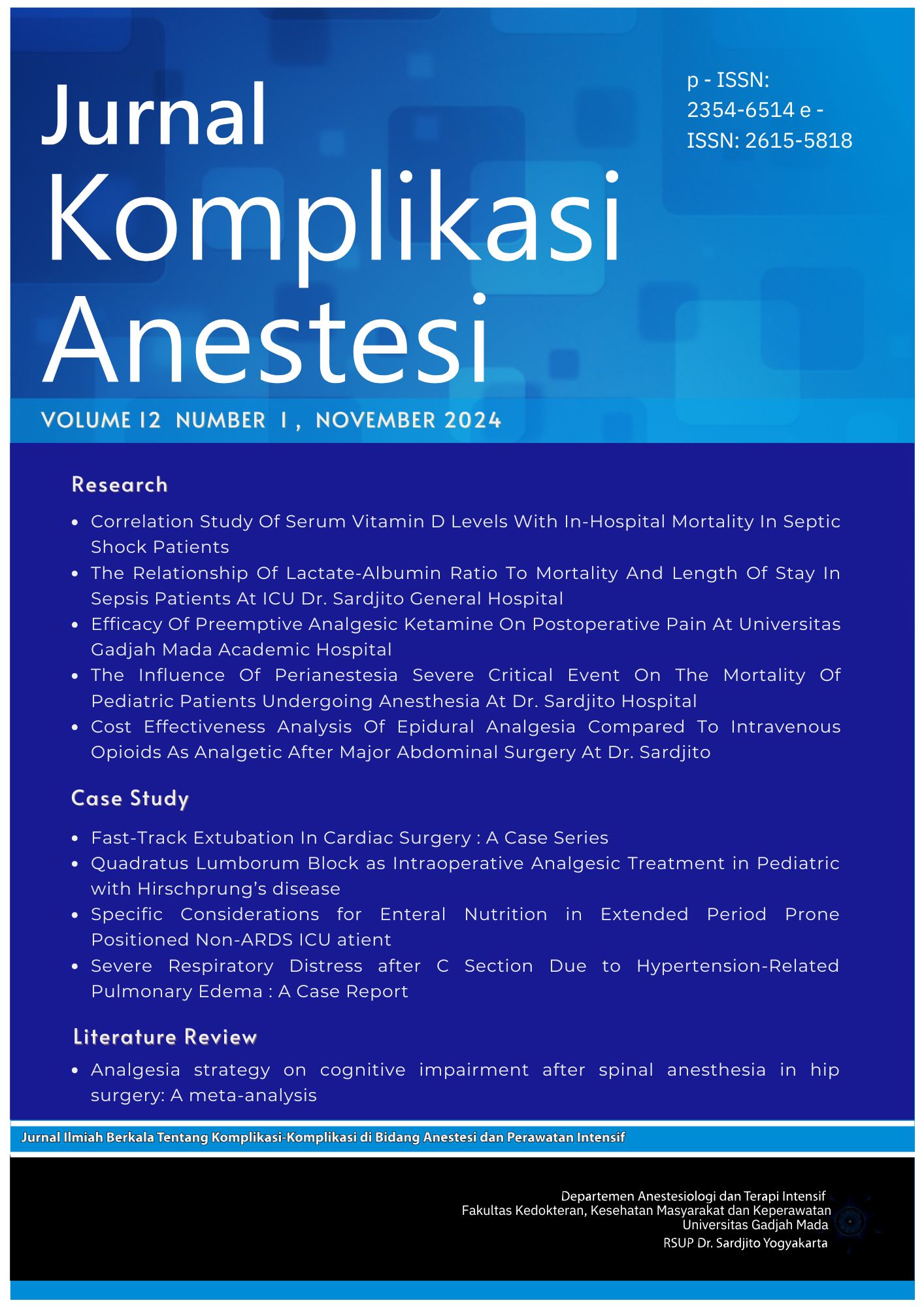EFFICACY OF PREEMPTIVE ANALGESIC KETAMINE ON POSTOPERATIVE PAIN AT UNIVERSITAS GADJAH MADA ACADEMIC HOSPITAL
Abstract
Background: Postoperative pain remains a problem in anesthesia services. Preemptive analgesics are known to reduce postoperative pain due to noxious stimuli during the perioperative period. Ketamine can be used as a preemptive analgesic because it has the ability to prevent central sensitization. However, studies on ketamine as a preemptive analgesic have not reached a conclusion. So further research is needed to prove the effectiveness of ketamine as a preemptive analgesic
Objective: This study aims to evaluate the efficacy of preemptive intravenous ketamine 0.5 mg/kgBW in reducing postoperative pain.
Method: This research is an experimental study with double-blind randomized controlled trials. The inclusion criteria for this study are oncology surgery patients, aged 18-65 years, ASA physical status 1 or 2, BMI 18-30, and willing to sign informed consent. Exclusion criteria include patients with contraindications to ketamine, chronic pain, long-term analgesic consumption, hypertension, diabetes mellitus, cerebrovascular disease, and a history of recurrent malignancy. Meanwhile, withdrawal criteria include withdrawing from the study and experiencing ketamine hypersensitivity. The research sample is randomly divided into 2 groups, namely Group A (ketamine preemptive) and Group B (control). Both groups receive the same anesthesia procedure, namely premedication with intravenous midazolam 0.05 mg/kg body weight (BW), fentanyl 2 mcg/kg BW intravenously, rocuronium 0.6 mg/kg BW intravenously (if intubation is performed), then after a confirmed onset, the LMA (laryngeal mask airway) or ETT (endotracheal tube) airway device is inserted. After that, for Group A, preemptive analgesic ketamine 0.5 mg/kg BW intravenously is administered 10 minutes before
surgical incision. The assessment performed is pain scale using the numerical rating scale (NRS) at rest and with movement, total intraoperative rescue fentanyl, total postoperative rescue fentanyl requirement, onset of postoperative rescue fentanyl requirement, and side effects. Observation is conducted for up to 12 hours postoperatively. All variables except side effects are analyzed with independent t-tests, but if the data distribution is not evenly spread, the Mann-Whitney test is conducted. The confidence interval in this study is 95%, with significance set at p < 0.05.
Results: A total of 65 subjects were studied, but 3 subjects dropped out of the study. Therefore, 62 subjects remained, with 31 subjects in each Group A and B. Statistically, Group A had lower NRS pain scores at rest compared to Group B at hours 0, ½, 1, and 2 postoperatively (p<0.05). For NRS on movement, Group A had lower NRS pain scores compared to Group B at hours 0, ½, 1, 2, 6, and 12 postoperatively (p<0.05). Group A had a longer onset of postoperative rescue fentanyl requirement compared to Group B (p<0.05). However, there was no significant difference in total intraoperative rescue fentanyl and total postoperative rescue fentanyl requirement (p>0.05).
Conclusion: Preemptive ketamine analgesic dose of 0.5 mg/kgBW intravenously is effective in reducing postoperative pain better than the control group. This is evidenced by lower NRS pain scores at rest and on movement, as well as a longer onset of postoperative rescue fentanyl requirement compared to the control group.
Copyright (c) 2024 David Ferdiansyah, Mahmud, Djayanti Sari

This work is licensed under a Creative Commons Attribution-ShareAlike 4.0 International License.
The Contributor and the company/institution agree that all copies of the Final Published
Version or any part thereof distributed or posted by them in print or electronic format as permitted herein will include the notice of copyright as stipulated in the Journal and a full citation to the Journal.

















